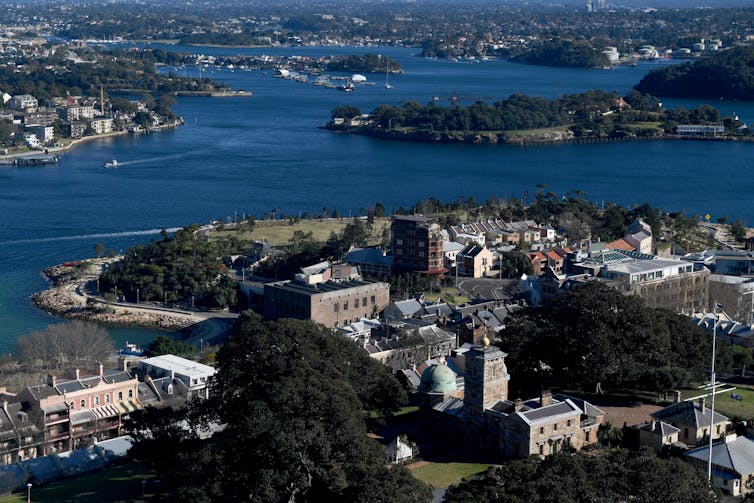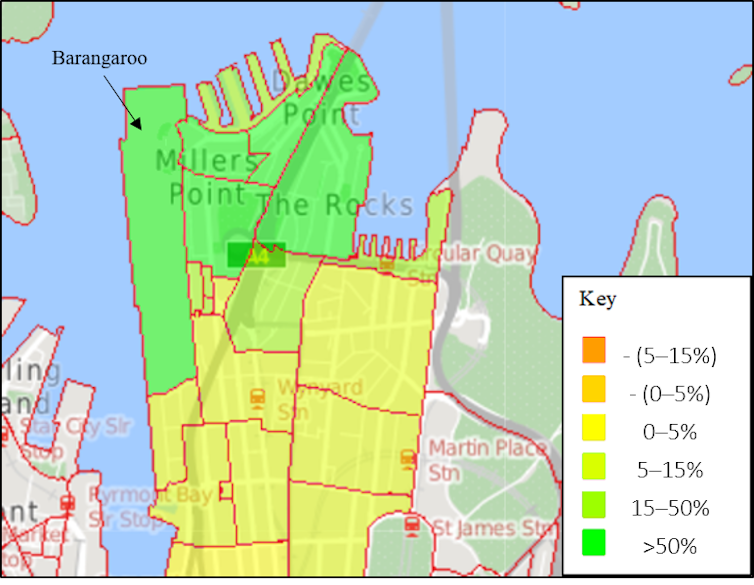Making developments green doesn’t help with inequality
- Written by Rupert Legg, PhD Candidate, University of Technology Sydney
Around the world, new developments are increasingly framed as sustainable to both policymakers and prospective buyers. They are seen as a “win-win” for the environment and the economy. However, recent concerns suggest social inequality often results.
Barangaroo is one such green development on the harbourfront in Sydney, Australia. What was once a contaminated, dilapidated, post-industrial wharf is now home to a six-hectare park, three office towers and two residential complexes. More is to come, in the form of a 275-metre hotel-casino.
Beyond its immense scale, Barangaroo is significant for another reason: it has a commendable sustainability agenda.
Rooftop solar partially powers the buildings, which are constructed from carbon-neutral materials and even provide a supply of recycled water from a stormwater treatment plant underneath. Beyond the project’s economic advantages – an estimated $2 billion-a-year boost to the New South Wales economy – the environment benefits through increased green space and biodiversity, along with reduced carbon emissions and electricity and water use.
These are undeniably beneficial outcomes. Yet, worryingly, such developments may result in “green gentrification” as increases to environmental amenity in an area result in displacement and exclusion of the disadvantaged.
I examined this claim at Barangaroo, by breaking its outcomes into three parts:
- who has access to the spaces it creates
- what happens to the surrounding property market
- how governance enables the outcome.
My findings suggest there is an urgent need to prioritise social outcomes in future sustainable development.
The spaces
Barangaroo has created many new spaces, but will people from all kinds of socio-economic backgrounds have access? Multiple hectares of public park and waterfront access, piers, laneways and bridges are accessible at the development. Retail spaces are scattered in between the office towers and residential complexes.
Around 900,000 people from the local Sydney region visited the public park in its first year alone. The commercial space, likewise, provides for 23,000 professionals.
To determine whether these statistics include the disadvantaged it is necessary to delve deeper. Who are those who live nearby? Who are employed in the offices? Who are the shops’ target market?
The price of floor space at Barangaroo is very high – around $20,000 per square metre for its apartments. Affordable housing has been moved offsite, so many will be priced out of living within Barangaroo.
Business giants, such as KPMG and Westpac, are among those that can afford to occupy the office space. Smaller, less professionally oriented businesses are unable to do so. The result is that retailers largely cater to office workers. David Jones, for instance, “has been carefully designed to appeal to Barangaroo’s big office community”.
Likewise, the new restaurants, owned by celebrity chefs and restaurateurs, appeal to those from high socio-economic backgrounds.
These trends provide little room for the disadvantaged to occupy the site’s residential, retail or commercial spaces. What about the public space, however? If those from low socio-economic backgrounds live around the development, they could enjoy these spaces.
 Barangaroo has created a new foreshore reserve, but are there still people from poorer backgrounds living nearby who might use this public space?
Brendan Esposito/AAP
Barangaroo has created a new foreshore reserve, but are there still people from poorer backgrounds living nearby who might use this public space?
Brendan Esposito/AAP
The property market
Green gentrification studies suggest sustainable developments may raise the prices of property nearby. Using data from the Australian Bureau of Statistics between 2011 and 2016, I found the rent prices in areas northeast of Barangaroo increased drastically.
 Rental price increases as a percentage in the areas surrounding Barangaroo.
Author provided
Rental price increases as a percentage in the areas surrounding Barangaroo.
Author provided
The main reason for this change was the selling of 214 public housing properties in Millers Point, Dawes Point and The Rocks in 2014. The NSW government announced the sales after Barangaroo’s effect on the surrounding areas began to take place, realising the increased profit to be made.
As a result, the development is not only exclusive on the inside, it has also contributed to the displacement of the disadvantaged from surrounding areas.
Read more: Last of the Millers Point and Sirius tenants hang on as the money now pours in
The governance
Could appropriate governance have prevented this? The political agenda that enabled this exclusion and displacement effectively ignored the disadvantaged. Counterclaims to the benefits of the development were ignored, as these did not match the win-win narrative of the development’s proponents.
For instance, the then NSW finance minister, Greg Pearce, dismissed the concerns of evicted residents by stating:
Millers Point is poorly suited for social housing … when considering its future, the government needs to consider it in the context of all of the surrounding areas, including the Barangaroo redevelopment area.
In a more extreme case, fast-tracked legislation made legally void a claim brought against the government for approving potentially unlawful elements of the development.
These actions minimise antagonistic voices, those that often act to promote social equality.
If future green developments are to minimise exclusion and displacement, they must allow participation from all sectors of society and recognise all the potential impacts in advance. The NSW government has not only enabled exclusion by failing to ensure affordable housing quotas, it has actively encouraged it by selling the nearby public housing.
Barangaroo is a missed opportunity: instead of promoting social equality, it has made inequality worse.
Authors: Rupert Legg, PhD Candidate, University of Technology Sydney
Read more http://theconversation.com/making-developments-green-doesnt-help-with-inequality-104941



















